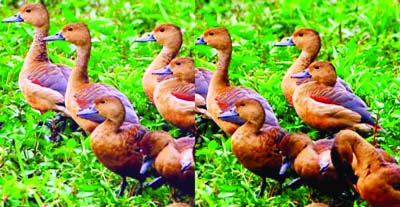
BSS, Rangpur :
The migratory birds have started arriving to the water bodies, beels, haors, marshy lands and major rivers in northern Bangladesh from the Himalayan and Siberian regions giving a descent look to the nature.
The number of arriving migratory birds marked fall in recent years as the Himalayan, Siberian, Nepal, Xinxian and Mongolian regions turned habitable to some extent for the birds even during the winters following rise in temperatures due to climate change.
According to local people, Bali Duck, Samukal, Bright, Rose King, Bali
Lenja, Chity, Sorail, Boikal, Nilshir, Piyang, Pankouri, Rangamuri, Pintail,Pantamukhi, Chokha-chokhi and Khonjona are now being found flocking to the water bodies in the region.
These birds, though little less in number, are now being found in Noonkhawa, Madarganj, Narayanpur, Berubari, Jatrapur, Begumganj, Hatia,Kodalkati, Astomirchar, Noyarhat, Mohanganj, Ketabkhan, Tazerhat and other places in the Brahmaputra, Teesta, Dudhkumar and Dharla rivers.
Local people have been observing arrival of the migratory birds in water of the Neel Sagar (Binnya Dighee) in Nilphamari, vast char areas in Rangpur,Gaibandha, Kurigram and Lalmonirhat and Alta Dighee water body of Dhamoirhat upazila in Naogaon district.
Horticulture Specialist of the Department of Agriculture Extension (DAE) Khandker Md Mesbahul Islam said migratory birds generally take shelters in the swamps, char areas, beels, haors and extended water bodies before they fly back from March.
“These migratory birds have been living now on the small fishes, insects, small snails and watery plants after arriving to the region to protect them from severe cold and fog in the Himalayan, Siberian, Nepal, Xinxian and Mongolian regions,” he said.
Agriculture and Environment Coordinator of RDRS Bangladesh Mamunur Rashid said the number of migratory birds is less now due to climate change, reduction of the water bodies and depletion of many species of sweet water fishes from the marshes.
As a result of the degrading climatic conditions, the number of arriving migratory birds has been decreasing in recent years in the region during the winters indicating further declinations in their number in near future, he added.
Associate Director-Agriculture of BRAC International (South Asia and
Africa) Dr M A Mazid said the adverse impacts of climate change have created severe threats to the bio-diversity side by side agriculture, ecology and environment sectors.
The number of arriving migratory birds has been reducing and their duration of stay shortening in the water bodies as the same are being dried up much earlier before the end of the winter season as a result of the climate change, he said.
Chilmari upazila chairman Shawkat Ali Sarker, Bir Bikram, said the number of visiting migratory birds in the Brahmaputra has been reduced in recent years though those have been visiting in large numbers during winters since the ancient times.
Elderly people living in vast char areas on the Brahmaputra, including
Khokan Mian, Nazim Uddin, Khatib Ali, Arfanullah and Liyakat Ali said number of the migratory birds has been reducing alarmingly in recent years.
The migratory birds have started arriving to the water bodies, beels, haors, marshy lands and major rivers in northern Bangladesh from the Himalayan and Siberian regions giving a descent look to the nature.
The number of arriving migratory birds marked fall in recent years as the Himalayan, Siberian, Nepal, Xinxian and Mongolian regions turned habitable to some extent for the birds even during the winters following rise in temperatures due to climate change.
According to local people, Bali Duck, Samukal, Bright, Rose King, Bali
Lenja, Chity, Sorail, Boikal, Nilshir, Piyang, Pankouri, Rangamuri, Pintail,Pantamukhi, Chokha-chokhi and Khonjona are now being found flocking to the water bodies in the region.
These birds, though little less in number, are now being found in Noonkhawa, Madarganj, Narayanpur, Berubari, Jatrapur, Begumganj, Hatia,Kodalkati, Astomirchar, Noyarhat, Mohanganj, Ketabkhan, Tazerhat and other places in the Brahmaputra, Teesta, Dudhkumar and Dharla rivers.
Local people have been observing arrival of the migratory birds in water of the Neel Sagar (Binnya Dighee) in Nilphamari, vast char areas in Rangpur,Gaibandha, Kurigram and Lalmonirhat and Alta Dighee water body of Dhamoirhat upazila in Naogaon district.
Horticulture Specialist of the Department of Agriculture Extension (DAE) Khandker Md Mesbahul Islam said migratory birds generally take shelters in the swamps, char areas, beels, haors and extended water bodies before they fly back from March.
“These migratory birds have been living now on the small fishes, insects, small snails and watery plants after arriving to the region to protect them from severe cold and fog in the Himalayan, Siberian, Nepal, Xinxian and Mongolian regions,” he said.
Agriculture and Environment Coordinator of RDRS Bangladesh Mamunur Rashid said the number of migratory birds is less now due to climate change, reduction of the water bodies and depletion of many species of sweet water fishes from the marshes.
As a result of the degrading climatic conditions, the number of arriving migratory birds has been decreasing in recent years in the region during the winters indicating further declinations in their number in near future, he added.
Associate Director-Agriculture of BRAC International (South Asia and
Africa) Dr M A Mazid said the adverse impacts of climate change have created severe threats to the bio-diversity side by side agriculture, ecology and environment sectors.
The number of arriving migratory birds has been reducing and their duration of stay shortening in the water bodies as the same are being dried up much earlier before the end of the winter season as a result of the climate change, he said.
Chilmari upazila chairman Shawkat Ali Sarker, Bir Bikram, said the number of visiting migratory birds in the Brahmaputra has been reduced in recent years though those have been visiting in large numbers during winters since the ancient times.
Elderly people living in vast char areas on the Brahmaputra, including
Khokan Mian, Nazim Uddin, Khatib Ali, Arfanullah and Liyakat Ali said number of the migratory birds has been reducing alarmingly in recent years.

